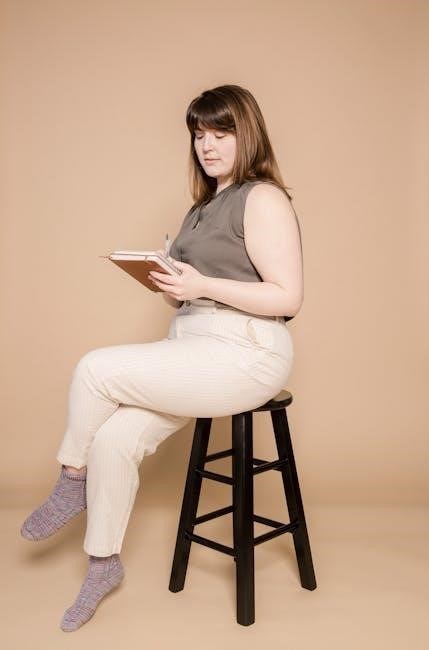OptiBond Solo Plus is a versatile dental adhesive designed for various restorative procedures. This guide provides step-by-step instructions for its proper use‚ ensuring optimal bonding outcomes.
Overview of OptiBond Solo Plus
OptiBond Solo Plus is a total-etch‚ single-component dental adhesive designed for bonding restorative materials to enamel and dentin. Its ethanol-based formula with barium glass fillers ensures strong‚ durable bonds. Suitable for various clinical applications‚ it simplifies restorative procedures with a straightforward application process. The adhesive is widely used in dental practices due to its reliability and versatility‚ making it a preferred choice for clinicians. Its unique composition and easy-to-follow instructions ensure optimal results in both direct and indirect restorative techniques. OptiBond Solo Plus is a trusted solution for achieving long-lasting dental restorations.
Importance of Following Instructions
Following the instructions for OptiBond Solo Plus is crucial for achieving optimal bonding outcomes. Proper preparation‚ application‚ and curing ensure the adhesive performs as intended‚ providing strong and durable bonds. Deviating from the recommended steps can lead to compromised bond strength‚ potentially causing restorations to fail prematurely. Adhering to the guidelines ensures patient safety and satisfaction‚ as well as the longevity of the dental work. Clinicians must carefully follow each step‚ from surface etching to curing‚ to maximize the adhesive’s effectiveness and maintain high standards of care.

Key Features of OptiBond Solo Plus
OptiBond Solo Plus features total-etch technology‚ a single-component adhesive system‚ and an ethanol-based formula with barium glass fillers‚ ensuring strong‚ durable bonds for various clinical applications.
Total-Etch Technology
OptiBond Solo Plus employs total-etch technology‚ ensuring a strong bond between dental surfaces and restorative materials. This method involves etching both enamel and dentin with a 37.5% phosphoric acid gel‚ such as Kerr Gel Etchant‚ for 15 seconds. The etching process creates microretentive surfaces‚ enhancing mechanical retention and promoting a durable bond. After etching‚ OptiBond Solo Plus is applied in a thin‚ even layer‚ followed by air-thinning to remove excess solvent. This step ensures proper infiltration of the adhesive into the etched surface‚ resulting in a reliable and long-lasting bond. The total-etch approach is versatile and suitable for various clinical applications‚ including restorative procedures and post fixation.
Single-Component Adhesive System
OptiBond Solo Plus is a single-component adhesive system‚ simplifying the bonding process by eliminating the need for multiple steps or components. Its ethanol-based formula ensures easy application and rapid evaporation‚ creating a thin‚ uniform layer. The system contains barium glass fillers‚ which enhance its durability and bonding strength. This design allows for efficient use in various clinical applications‚ including restorative procedures and core materials. The single-component nature reduces chair time and minimizes the risk of errors‚ making it a reliable choice for dental professionals. Its streamlined application process ensures consistent results‚ adhering to the tooth structure effectively.
Ethanol-Based Formula with Barium Glass Fillers
OptiBond Solo Plus features an ethanol-based formula that ensures rapid evaporation‚ creating a thin‚ uniform layer for optimal bonding. The inclusion of barium glass fillers enhances the adhesive’s strength and durability‚ providing a reliable bond between the tooth and restoration. These fillers‚ measuring 0.4 microns‚ contribute to a strong mechanical bond and are also found in Kerr’s Point 4 composite‚ ensuring compatibility and consistency. This unique combination of ethanol and barium glass fillers makes OptiBond Solo Plus highly effective in various clinical applications‚ offering both ease of use and long-lasting results. The formula is designed to adhere well to enamel and dentin‚ ensuring a secure bond.

Preparation for Application
Ensure the tooth surface is clean and dry. Use Kerr Gel Etchant for etching enamel and dentin. Handle the adhesive bottle carefully‚ shaking it gently before use.
Surface Etching with Kerr Gel Etchant
Surface etching is a critical step before applying OptiBond Solo Plus. Use Kerr Gel Etchant (37.5% orthophosphoric acid) to etch both enamel and dentin for 15 seconds. This process creates a microretentive surface‚ enhancing the bond between the tooth structure and the adhesive. After etching‚ thoroughly rinse the surface with water to remove any residual acid. Gently dry the area with compressed air to ensure a clean‚ moisture-free surface for optimal adhesion. Proper etching ensures the adhesive penetrates evenly‚ promoting a strong and durable bond. Avoid over-etching‚ as it may compromise enamel integrity. This step is essential for achieving reliable results with OptiBond Solo Plus.
Handling the Adhesive Bottle
Before use‚ gently shake the OptiBond Solo Plus bottle to ensure uniform consistency. Apply a few drops on a disposable mixing pad. Use a light brushing motion to spread the adhesive evenly across the prepared surface. Avoid pooling or over-application‚ as this can compromise bond strength. Store the bottle at room temperature‚ away from direct sunlight‚ to maintain its effectiveness. Ensure the cap is tightly sealed after use to prevent contamination or evaporation. Proper handling ensures the adhesive remains effective and ready for use in various clinical applications‚ from restorative procedures to post fixation.

Application Process
Gently shake OptiBond Solo Plus‚ apply drops on a mixing pad‚ and brush evenly onto prepared surfaces. Air-thin for 3 seconds‚ then cure with light for optimal bonding.
Shaking and Mixing OptiBond Solo Plus
Begin by gently shaking the OptiBond Solo Plus bottle for 5-10 seconds to ensure uniform distribution of components. Place one drop each of OptiBond Solo Plus and its activator on a disposable mixing pad. Mix thoroughly with a clean applicator for 10-15 seconds‚ ensuring a smooth‚ even consistency. Avoid over-mixing‚ as this may introduce air bubbles. Proper mixing is critical for achieving optimal bonding performance and ensuring the adhesive’s effectiveness in clinical applications. Mixing pads should be replaced after each use to maintain hygiene and prevent cross-contamination.
Applying the Adhesive
After mixing‚ apply OptiBond Solo Plus to the prepared tooth surface using light brushing motions. Cover the entire area evenly‚ ensuring complete coverage of the enamel and dentin. Apply for 15 seconds to allow proper penetration and bonding. Avoid pooling or over-application‚ as this can compromise the bond strength. Use a clean applicator to spread the adhesive thinly and uniformly. Once applied‚ proceed to the next step of air-thinning to remove excess material and create a uniform layer. Proper application ensures optimal adhesion and durability of the restoration. Follow the manufacturer’s guidelines for consistent results.
Air-Thinning the Layer
Air-thinning is a critical step after applying OptiBond Solo Plus. Use compressed air to gently thin the adhesive layer‚ ensuring even coverage without pooling. Hold the air syringe at a 45-degree angle‚ 10-15 cm away from the surface. Air-thin for 3 seconds to remove excess material and create a uniform film. Avoid over-thinning‚ as this may reduce bond strength. This step ensures the adhesive layer is optimal for bonding‚ promoting durability and longevity of the restoration. Proper air-thinning is essential for achieving a strong‚ reliable bond between the tooth and restoration material. Follow this step carefully to ensure the best clinical outcomes.

Curing Process
OptiBond Solo Plus requires proper curing for optimal bonding. Use a high-intensity curing light at 450-480 nm for 10-20 seconds. Ensure complete polymerization for durability;
Light Curing Techniques
Light curing is essential for polymerizing OptiBond Solo Plus. Use a high-intensity curing light with a wavelength of 450-480 nm. Hold the light at a 45-degree angle‚ 10-15 mm away from the surface. Cure for 10-20 seconds‚ ensuring complete coverage. Avoid direct light exposure to the adhesive before curing. For optimal results‚ cure in a well-ventilated area to prevent overheating. Proper technique ensures a strong‚ durable bond. Always follow the manufacturer’s guidelines for light curing to achieve the best outcomes in clinical applications. This step is critical for the long-term success of the restoration or bonding procedure.
Recommended Curing Time
The recommended curing time for OptiBond Solo Plus is 10-20 seconds for the adhesive layer. For restorative materials applied afterward‚ cure each layer for at least 40 seconds. Ensure the light intensity is sufficient‚ typically between 1‚000-2‚000 mW/cm²; Proper curing ensures optimal polymerization and bond strength. Exceeding the recommended time does not enhance results but may over-cure the material. Follow the manufacturer’s guidelines to achieve the best outcomes. Consistent curing times are critical for the durability and success of the restoration. Always monitor the curing process to maintain consistency and avoid under- or over-curing the adhesive or restorative material.

Clinical Applications
OptiBond Solo Plus is ideal for restorative procedures‚ post fixation‚ and core materials. It is also suitable for amalgam sealing‚ ensuring durable and reliable dental restorations;
Restorative Procedures
OptiBond Solo Plus is widely used in restorative procedures for bonding composite resins‚ ceramics‚ and other materials. It ensures a strong‚ durable bond between the tooth structure and restoration. After etching the enamel and dentin with Kerr Gel Etchant‚ apply OptiBond Solo Plus gently for 15 seconds. Air-thin the layer for 3 seconds to prevent pooling. Light-cure according to the manufacturer’s instructions. This adhesive is ideal for direct restorations‚ veneers‚ and crowns‚ offering excellent compatibility with various restorative materials. Its ethanol-based formula with barium glass fillers enhances bond strength and durability‚ making it a reliable choice for clinical applications.
Post Fixation and Core Materials
OptiBond Solo Plus is effective for post fixation and core material applications‚ ensuring a strong bond between the tooth and restoration. After etching with Kerr Gel Etchant‚ apply OptiBond Solo Plus in a thin‚ even layer. Allow the adhesive to air-thin for 3 seconds before light-curing. This step enhances bonding efficiency and prevents pooling; For post fixation‚ apply the adhesive to both the post and preparation space‚ curing afterward. Core materials benefit from its barium glass fillers‚ which improve durability. OptiBond Solo Plus is ideal for such procedures‚ providing long-lasting stability and compatibility with various dental materials‚ making it a trusted choice for clinicians in complex restorative cases.

Safety Precautions
Handle OptiBond Solo Plus carefully to avoid skin and eye contact. Store in a cool‚ dry place‚ away from direct sunlight. Dispose of waste properly.
Handling and Storage Guidelines
OptiBond Solo Plus should be stored in a cool‚ dry place away from direct sunlight and heat sources. Keep the bottle tightly closed when not in use to prevent contamination. Avoid exposing the adhesive to extreme temperatures or moisture‚ as this may alter its properties. Handle the product with clean‚ dry gloves to prevent skin contact. Ensure the bottle is upright during storage to avoid leakage. Do not use expired products‚ as this can compromise bonding effectiveness. Proper disposal of unused material and packaging should follow local regulations. Always refer to the product label for specific storage instructions.
Following the instructions for OptiBond Solo Plus ensures successful outcomes in dental procedures. Proper preparation‚ application‚ and curing techniques are essential for achieving reliable bonds. The product’s unique features‚ such as its ethanol-based formula and barium glass fillers‚ make it versatile for various clinical applications. Adhering to handling and storage guidelines maintains its effectiveness. By following these steps‚ dental professionals can consistently achieve high-quality results. OptiBond Solo Plus is a trusted solution for restorative procedures‚ offering durability and efficiency. Mastering its application enhances patient care and satisfaction‚ making it a valuable tool in modern dentistry.
